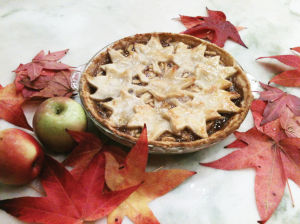As soon as the leaves begin to fall from the sycamore tree outside my house, the comforting scent of warm pie starts to waft from my oven. November is a time for pies, and I strongly believe there is no need to wait until Thanksgiving to bake your first one. Though a good old-fashioned apple or pumpkin pie is never a bad choice, I have gathered some tips to give your pies a little more spunk this autumn.

Any delicious pie starts with a flaky crust. Flour and butter come together with a splash of water and a sprinkle of sugar to form the crucial bed for the pie. While a food processor can make the task of creating a pie crust simple, with a little more manpower two knives can get the job done just as well.
The key to a great crust is keeping it cold. Keep the butter chilled before incorporating it into the dough. Maintaining a chilled dough allows the butter to mix properly in the flour mixture, which results in a wonderfully flaky crust.
The most basic pie crust has four simple ingredients –flour, water, sugar, and lots of butter. However, it is easy to modify this traditional recipe. By adding finely crushed walnuts or pecans, a taste of autumn can be created inside the crust.
Next comes the filling – this is what truly defines the pie.
The typical pumpkin pie recipe calls for canned pumpkin, condensed milk, sugar, and spices. While this familiar taste can be comforting, it can also be bland, heavy, and dry.
As an alternative, use a fresh pumpkin while making the filling to enhance the flavor of the pie. I recommend the sweet and orange Sugar Pie pumpkin or the more savory green Kabocha pumpkin.
Slice the pumpkin into quarters, scoop out the seeds, place the pumpkin slices face down in a baking pan, and cover with half an inch of water to keep them moist. Put the pan in the oven at 350 degrees for about 30 minutes.
After the pumpkin is cooked, scrape out the inside and puree it in a mixer. If there is no time to make puree from scratch, Trader Joe’s organic canned pumpkin is the next best option because, without any added preservatives, it maintains a fresh, straight-from-the-patch taste.
Sweet potatoes are also a viable alternative as they have the essential earthy taste.
Most pumpkin pie recipes also call for heavy condensed milk. However, this is easily substituted with coconut milk, which lightens the mixture and adds a slightly tropical flavor that is not overbearing. Eggnog is also a good option that provides a thicker, richer flavor.
Additionally, I often experiment with replacements to white sugar. For a richer flavor, I’ll add maple syrup and brown sugar instead of white sugar. Sometimes, I add a dash of vanilla extract and a spoonful of molasses to thicken and intensify the mixture.
Spices are the key to a pumpkin pie as they suppress the taste of squash in a pumpkin. Cinnamon, nutmeg, cloves, and fresh ginger are essential spices, but more adventurous bakers might want to try cardamom.
For my pumpkin pies, I sometimes swirl a drizzle of molasses on top before popping them in the oven to create a more avant garde look. Or, I go for the simple pumpkin cutout created by placing extra crust dough in the middle of the pie.
Pumpkin pie may epitomize fall, but you can never go wrong with a slice of warm apple pie.
To make an apple pie, blend a variety of sweet and sour apples. Old and overripe apples can add an impressive taste in a pie—these can be picked up at the farmer’s market for half price.
Coat the apples with maple syrup and brown sugar or use caramel sauce to make a caramel apple pie. Heaps of cinnamon will make any apple pie marvelous. To add texture or color to the pie, try adding diced walnuts or cranberries.
Once the crust and filling is put in the pie pan, garnish the top with a lattice design, or if you’re feeling bold, make a pile of leaves using leaf-shaped cookie cutters.






